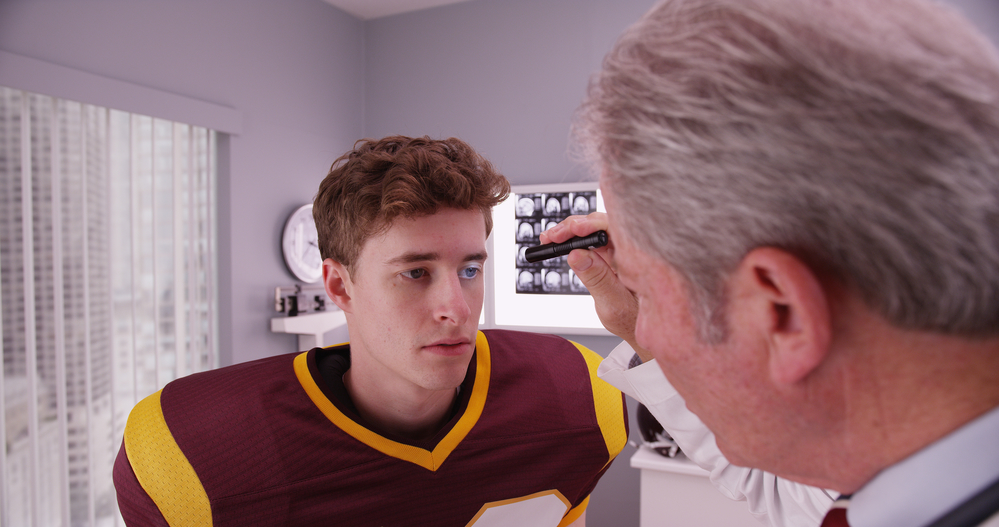Concussions: What You Need to Know

Youth sports can teach kids so many valuable lessons, like teamwork, collaboration and the importance of physical fitness. Yet they do come with risks.
According to the National Athletic Trainers’ Association, sports-related concussions account for more than half of emergency room visits among children ages 8 through 13. And studies have shown that more than 50 percent of high school athletes and 70 percent of college athletes failed to report concussions sustained playing football.
While concussions are prevalent, especially in sports, athletes can take steps to prevent concussions, and they can typically make a full recovery when treated properly. We spoke with Dr. James Gilbert, a sports medicine specialist with a particular expertise in concussion management. He practices with our Metro Orthopaedics & Sports Therapy care center.
What exactly is a concussion?
By definition, a concussion is a mild traumatic brain injury with no radiographic evidence, which means they are frequently difficult to diagnose. Concussions create neurochemical differences in the brain which often have a long-term impact, particularly in individuals who have repeat concussions. For patients with repeat concussions, they often experience passive physiological changes to the brain similar to what we see in Alzheimer’s patients and those with certain types of dementia.
How might a patient get a concussion?
Patients typically get a concussion as a result of an impact injury to the head through acceleration and deceleration mechanisms that damage internal structures and cells in the brain. When I explain concussions to my patients who do not have a medical background, I like to compare the brain to jello, while the neurons look like very thin wires throughout the brain. When you hit your head or experience an acceleration and deceleration mechanism, your brain jiggles and the neurons can get injured.
Are there certain activities or sports that put patients at a higher risk for these types of injuries?
The highest injury rates are in football and other high energy impact sports like hockey, but all sports come with some risk. However, the industry has made advances in decreasing the incidence of concussions by improving protective equipment and changing rules surrounding tackling, etc. I previously worked with Major League Soccer and U.S. Soccer in a medical capacity, and we employed third party observers who would watch out for potential head injuries that coaches and physicians on the sidelines may have missed. If they see a player head the ball or collide with another player, they will radio down to the medical team to make sure each incident is thoroughly reviewed. These types of changes have made a difference in the treatment of concussions and head injuries.
Can you explain the different symptoms patients may experience with a concussion?
There are several symptoms patients may experience including headaches, dizziness, nausea, vomiting, sensitivity to light, coordination problems and balance issues. Many of the early signs of concussion are cognitive, and we’ll see patients having difficulty with memory and recall which is why we use neurocognitive tests to diagnose concussions. Oftentimes in athletes, physicians will conduct a baseline test before the season begins, and can compare neurocognitive tests if they suspect a concussion during the season.
There is a great deal of research being done to improve how we test and diagnose concussions. In the future, I expect we will be able to diagnose concussions through a blood or saliva test, as we’ll be able to isolate proteins in the blood that would be elevated in patients who have a concussion. These tests will help us track concussion patients and will help us to determine when it is safe to return to play.
How is a concussion treated?
Just like any other part of the body, you have to rest the brain and let it recover without giving it another challenge or injury. We are learning that certain individuals don’t recovery as quickly as others, so we think there may be a genetic component that makes individuals more likely to experience concussions and requiring longer recovery times. These patients may also be more likely to experience another concussion and have neurocognitive deficits down the road as well. We think people who are slow to recover aren’t healing brain tissue like normal individuals so there is a lot of research into identifying those genes.
Treating concussions seems to be an interest of yours. How involved are you in advancing concussion treatment?
Treating concussions correctly is so important and it’s a topic I am very passionate about. There is still so much we don’t know about caring for injured brains and we need more research and funding for these programs. If we can develop a blood or saliva test as I mentioned earlier, we can more accurately diagnose patients and we’ll have a more concrete idea of when they can return to play. We aren’t too far from that.
I’ve been involved in President Barack Obama’s Concussion Summit, and I have participated in Major League Soccer’s concussion committee. We have a concussion management center at our office in Silver Spring and we are working to build a larger concussion management center for CAO as a whole.
James Gilbert, M.D., is the President and CEO of the Metro Orthopaedics & Sports Therapy care center in Silver Spring, Maryland. Dr. Gilbert specializes in sports medicine and has served as head team physician in professional soccer for over 15 years. He has also served as an assistant team physician and consultant for Duke Sports Medicine, the Dallas Cowboys, the Dallas Mavericks, the Professional Bull Riders Association and the Special Olympics.

